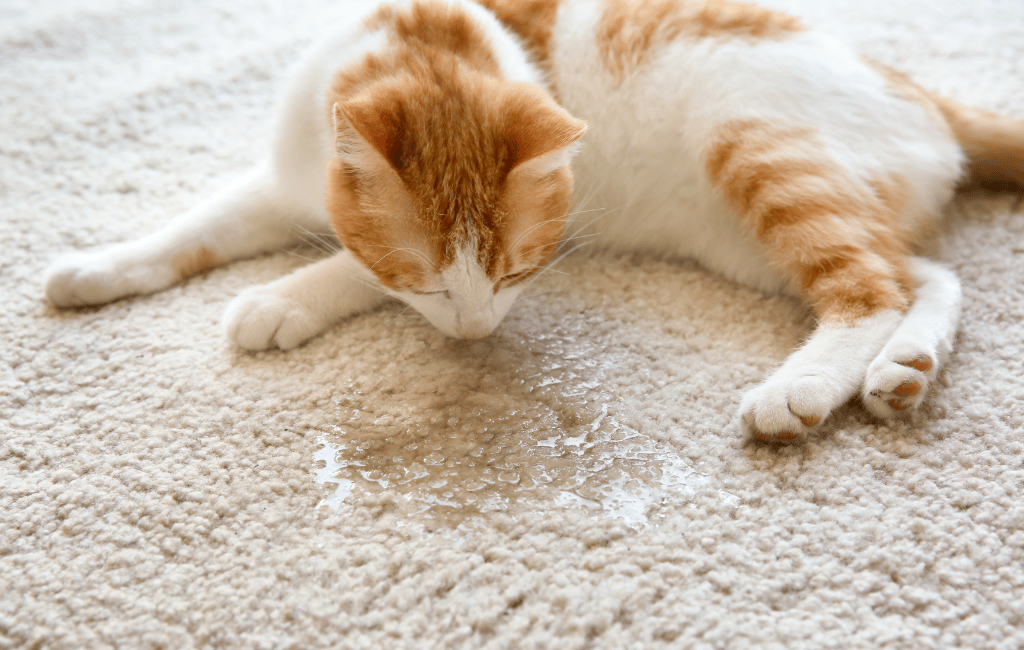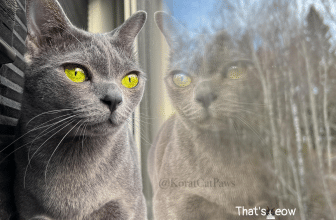
Did you ever come home and found that your kitty decided to freshen up your living room with a strong breeze of “Skunk Essence”?
Cat pee is more than meets your nose, and for cats peeing also means communicating.
In this article, you will find out how normal cat pee is supposed to smell, why cat urine has such a strong odor, and what are the differences between spraying and peeing.
And, if you stick to the end, you’ll even learn how to effectively remove cat pee from your things.
Table of content [click to expand]
How to tell if your cat’s urine is normal

Cat urine is not so different from other animals’ urine, however, if unnoticed and not cleaned in time, the cat pee will develop a strong pungent smell, with a slightly suffocating odor like no other pee you ever smelled before.
Cat pee is a concentrated metabolic waste made out of 95% water, 2% urea, and about 3% of various detoxified substances like proteins and amino acids (creatinine, felinine), urine electrolytes (sodium, chloride), ammonia, uric acid, pheromones, and bacteria.
A healthy cat’s urine should be clear and not difficult to see through, from colorless to a golden color (usually just pale yellow), and have a slightly acidic and pungent smell. Spayed and neutered cats will eliminate urine that is not so strong.
back to menu ↑Why does cat pee smell so strong?
Cat pee eventually smells bad, because, with time, the bacteria will decompose the urea in cat urine releasing ammonia and emitting pungent compounds called mercaptans (also found in skunk spray), giving the cat urine its distinctive ammoniacal odor, that makes your eyes water!

Another reason why a cat’s pee could smell very bad can be that your cat is getting old and has kidney issues, and the cat pee is more concentrated.
Also, we can say cat pee is unique because it contains felinine, an amino acid found in cat urine that is specific to felines. Felinine breaks down into sulfur-containing compounds that also emanate pungent odors, which humans normally can’t smell.
Males that are not neutered produce three times the amount of felinine in their urine, and the odors released help them mark their territory and attract females.
This makes cat urine difficult to remove. To a human nose, the odor left behind after cleaning cat pee with normal cleaning products is untraceable, but cats can still smell the pheromones from the felinine.

Regular cleaners cannot eliminate the pheromones and other volatile sulfur-containing compounds from cat urine, so to properly clean out cat urine you will need an enzyme-based cleaner. Not cleaning with a proper enzyme-based remover will most probably result in your cat urinating or marking in the same spot over and over, even if you already cleaned it before.
back to menu ↑Cat spraying vs peeing, what’s the difference?
As I pointed out before, cats communicate through the way they urinate. The proper use of a litter box can indicate that your cat is happy. Peeing outside the box can be the way your cat is telling you that is suffering from some health issues and you need to investigate. Also, cats use their urine as markers to establish territory or send mating signals.
Spraying is when a cat is peeing on vertical objects to let other cats know they are invading their territory or to signal cats of the opposite sex that they are in heat and ready to mate.

Spraying happens normally when a cat feels threatened and you’ve brought a new cat into the household, or maybe a neighborhood cat has entered your cat’s premises. Spraying can also happen more when your cat is not spayed or neutered and looking for a mate, this being their way of attracting other cats.
When a cat sprays, no matter if it’s a male or a female, the cat will back up against a vertical surface like furniture or a wall and will raise its tail to release a small amount of urine. This urine smell should be more strong than normal urine.
Urine marking is when a cat squats on the ground and eliminates small amounts of urine on horizontal surfaces. This is another way for cats to mark territory and communicate their dominance issues, their desire to mate, or if they are under anxiety or stress.

Most cats that show this behavior will mark several areas of your house with small amounts of urine one right after another.
Accidental peeing appears in a big amount on horizontal surfaces when your cat is anxious and can’t make it to its litter box in time, so they just have an accident on the floor or a carpet. This type of urinating outside the box usually indicates that your cat can’t hold its urine and might have a health problem.

Peeing outside the box can also just be the fact that your cat is not happy with how clean its litter box is, or you recently changed their litter box or the location of it and they don’t like the size of the new box or the type of cat litter that you recently use, or they don’t feel safe in the new location of the litter box.
Normal peeing is when your cat is using properly the litter box, peeing whilst squatting down and then covering their waste, which means the litter box is clean and they feel safe to use it.

Some of the medical problems related to peeing outside the box can include:
– Kidney disease
– Urinary tract infections
– Feline lower urinary tract disease
– Hyperthyroidism
– Diabetes
If you have any reason to suspect that your cat is showing any symptoms of these conditions please bring them to your veterinarian.

How to quickly and permanently remove cat urine stains
The only cleaning product that will effectively clean cat urine is an enzyme-based cleaner because it is capable of breaking down the uric acid from cat pee and completely eliminating the odor.

What is an enzyme-based cleaner?
Enzyme cleaners are cleaning agents that contain beneficial bacteria which release enzymes that break down molecules present in urine, feces, and food, into smaller molecules and accelerate the chemical process. Once the enzymatic reaction is complete, the bacteria start to consume those smaller molecules, efficiently cleaning stains and neutralizing the urine smell.
For cat urine, the enzyme cleaner breaks up the urea into two gases that easily evaporate, carbon dioxide and ammonia.
To get rid of cat pee from your carpet, clothes, or furniture you need first to find the urine-soiled area. When the urine is still fresh it’s easier to see, especially on white surfaces, but once it dries off it can be harder to spot, although surely easier to smell.

If you can not see a urine mark, you can use an ultraviolet black light to make it glow in the dark.
For detecting cat urine, a black light in the range of 365-385 nanometers has the best results.
Once you located the urine mark, it’s time to remove it.
back to menu ↑How to properly use an enzymatic cleaner:
- Step 1: If the urine is fresh, absorb as much of the urine as you can with paper towels
- Step 2: Soak (don’t spray it, drench it!) the affected area with the enzyme cleaner
- Step 3: Let the enzyme cleaner sit as instructed on the bottle
- Step 4: Absorb up as much of the enzyme cleaner as possible with paper towels.
- Step 5: Leave the enzyme cleaner to dry naturally.
From Steps 2 to 5, the same process applies to an old urine stain, the only difference is that you probably need to repeat the procedure two or three more times to make sure the stain is completely clean and the smell has been neutralized. Allow the affected area to completely dry between applications.
In the article below you can find my best picks of pet-safe enzyme-based cat urine removers.

Here are my top 3 favorites:
How to make a homemade cleaner for cat urine stains and odors
If you don’t have an enzyme-based cleaner handy, you can make your own cleaner at home.
This solution will temporarily work on fresh and maybe old cat pee stains.
You will need white vinegar, water, baking soda, liquid dish soap, and 3% hydrogen peroxide.
For a fresh (still wet) cat urine spot, first, soak up the excess urine with a paper towel.
- Step 1: Mix in a spray bottle equal amounts of white vinegar and water. The acidity of the vinegar neutralizes bacteria in cat pee and eliminates the ammonia odor. Spray it in abundance on the affected area then soak away the mixture with paper towels or an old cloth/towel. Don’t use vinegar on marble or stone surfaces.
- Step 2: Sprinkle baking soda over the affected area. Baking soda is a natural cleaner that neutralizes the compounds with acidic properties in cat urine absorbing the odor and acting like a deodorant. Let the baking soda sit for 15 to 30 minutes, it helps draw out the urine
- Step 3: Mix 3% hydrogen peroxide and 1 teaspoon of liquid dish detergent. Sprinkle this mixture over the baking soda and scrub it thoroughly into the affected area with a cloth, or use a bristle brush for carpets. Rinse the cloth a few times as needed and scrub the mixture in until you are sure it got through all the soiled areas. Then soak up the area with paper towels.
- Step 4: Let it stain dry. Once the spot is dry, you can vacuum the excess baking soda.

This concoction will still not guarantee that the cat odor is completely removed from a surface because even though vinegar, baking soda, soap, and hydrogen peroxide are good at temporarily deodorizing and cleaning the stain, they do not break down the uric acid from the urine. So, the uric acid salts left behind, when exposed to humidity, cause the uric acid crystals to form again, hence the bad urine smell will come back to haunt you. You might not smell it, but your cat surely will!
back to menu ↑Final thoughts
Cats use urine to mark their territories and fend off intruders, or they use their urine to show that they are ready to mate and attract other cats. They can also urine-mark horizontal surfaces to show unhappiness, stress, or anxiety. The way a cat uses its litter box can tell you if your cat is happy, or if something is off with its health.
Don’t forget that a cat’s urine contains felinine which releases pheromones that help them in marking their territory and attracting mates. If you don’t clean the spot where your cat sprayed with an enzyme-based cleaner, your cat will keep peeing in the same spot over and over again, because they can still smell the pheromones, even if you don’t.











